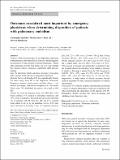| dc.contributor.author | Kabrhel, Christopher | |
| dc.contributor.author | Sacco, Weston | |
| dc.contributor.author | Liu, Shan Woo | |
| dc.contributor.author | Hariharan, Praveen | |
| dc.date.accessioned | 2011-09-29T15:08:04Z | |
| dc.date.issued | 2010 | |
| dc.identifier.citation | Kabrhel, Christopher, Weston Sacco, Shan Liu, and Praveen Hariharan. 2010. Outcomes considered most important by emergency physicians when determining disposition of patients with pulmonary embolism. International Journal of Emergency Medicine 3(4): 239-264. | en_US |
| dc.identifier.issn | 1865-1372 | en_US |
| dc.identifier.uri | http://nrs.harvard.edu/urn-3:HUL.InstRepos:5146969 | |
| dc.description.abstract | Purpose: Clinical decision rules for the disposition of patients with pulmonary embolism (PE) are typically validated against an outcome of 30-day mortality or disease recurrence. There is little justification for this time frame, nor is it clear whether this outcome reflects emergency department (ED) decision making. Aims: To determine which outcomes emergency physicians (EP) consider most relevant to disposition decisions. Methods: Survey of attending EPs in geographically diverse US states using acute PE as the diagnostic framework. Responses required single-answer multiple choice, a numerical percentage, rank-ordered responses, or a five-point Likert scale. We distributed the survey via e-mail to 608 EPs. Results: We received responses from 292 (48%) EPs: 88% board certified, 91% trained in emergency medicine, and 70% work in academics. Respondents reported discharging 1% of patients with PE from the ED, but 21% reported being asked to do so by an admitting service. EPs were more interested in knowing 5-day (in hospital) outcomes [192/265, 72% (95% exact CI=66%–78%)] than 30-day outcomes [39/261, 15% (95% exact CI=11%–20%)] or 90-day outcomes [29/263, 11% (95% exact CI=8%–15%)]. On a Likert scale, 212/241 (88%, 95% exact CI=83%–92%) agreed or strongly agreed that they considered 5-day (in hospital) clinical deterioration when making a decision to admit or discharge a patient from the ED compared to 184/242 (76%, 95% exact CI=70%–81%) and 73/242 (30%, 95% exact CI=24%–36%) for 30 and 90 days, respectively. A wide variety of clinical outcomes beyond death or recurrent PE were considered indicative of clinical deterioration. Conclusions: Five-day (in hospital) outcomes that incorporate a variety of clinical deterioration events are of interest to EPs when determining the disposition of ED patients with PE. Researchers should consider this when developing and validating clinical decision rules. | en_US |
| dc.language.iso | en_US | en_US |
| dc.publisher | Springer-Verlag | en_US |
| dc.relation.isversionof | doi:10.1007/s12245-010-0206-8 | en_US |
| dc.relation.hasversion | http://www.ncbi.nlm.nih.gov/pmc/articles/PMC3047862/pdf/ | en_US |
| dash.license | LAA | |
| dc.subject | clinical decision rule | en_US |
| dc.subject | outcomes | en_US |
| dc.subject | emergency department | en_US |
| dc.subject | pulmonary embolism | en_US |
| dc.subject | venous thromboembolism | en_US |
| dc.title | Outcomes Considered Most Important by Emergency Physicians When Determining Disposition of Patients with Pulmonary Embolism | en_US |
| dc.type | Journal Article | en_US |
| dc.description.version | Version of Record | en_US |
| dc.relation.journal | International Journal of Emergency Medicine | en_US |
| dash.depositing.author | Kabrhel, Christopher | |
| dc.date.available | 2011-09-29T15:08:04Z | |
| dash.affiliation.other | 100170 | en_US |
| dash.affiliation.other | 100170 | en_US |
| dc.identifier.doi | 10.1007/s12245-010-0206-8 | * |
| dash.contributor.affiliated | Liu, Shan | |
| dash.contributor.affiliated | Kabrhel, Christopher | |


